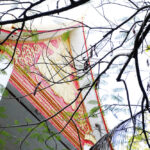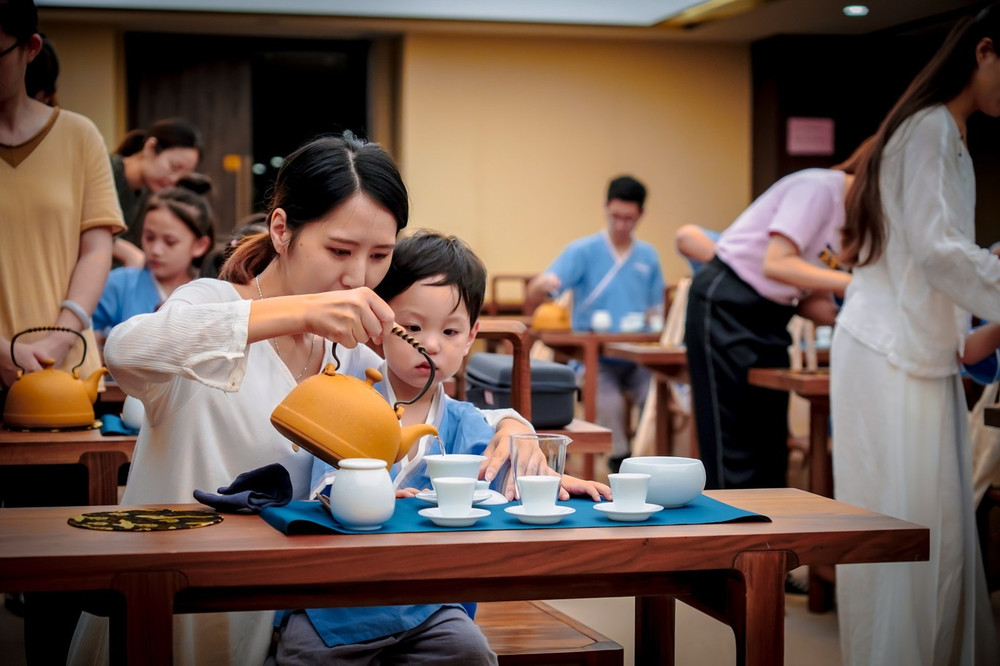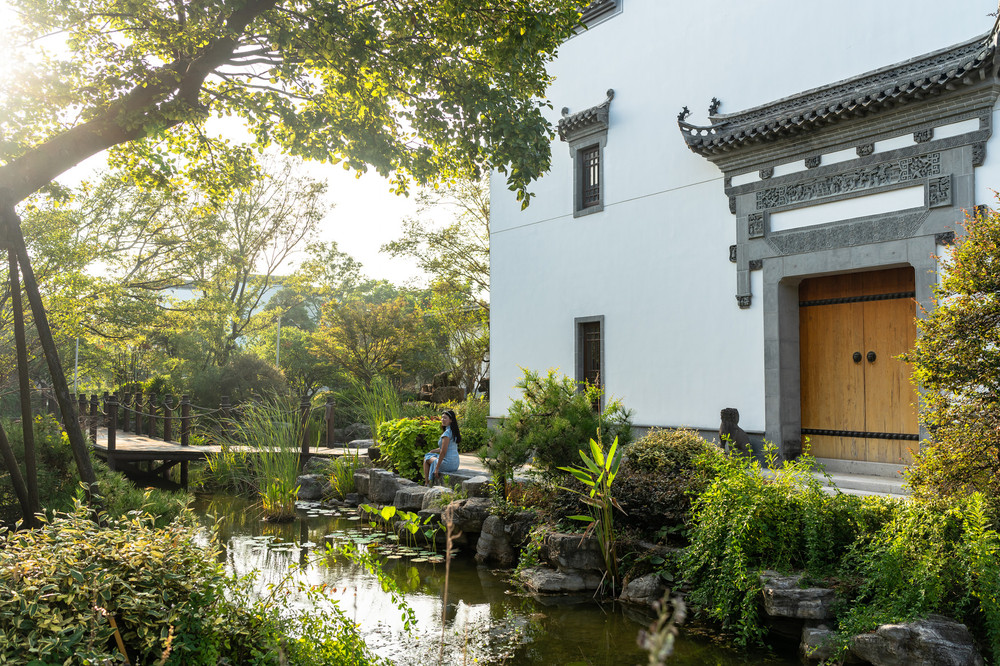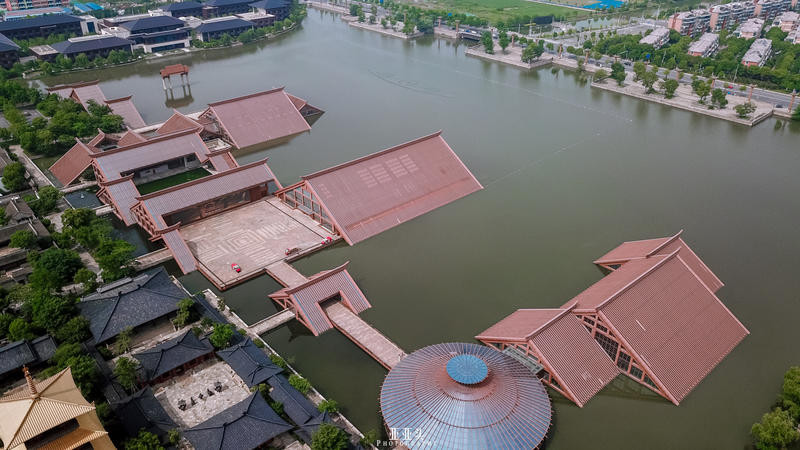**How to Play: Food**

*Published on November 25, 2022, at 14:02*
This article is an abridged version of the original piece titled ‘The Sea-Style Flavors in a Legendary Small Western-Style House, Many Celebrities Have Visited Especially,’ which first appeared on ‘Gourmet Platform’ in September 2022. Yong Foo Elite, once the official residence of Dr. Kuang Ankun from Ruijin Hospital, has a history of serving as the consulate for the Soviet Union, Germany, the United Kingdom, and other nations. Since its opening in 2004, Yong Foo Elite has embraced multiple cultural identities: a Michelin-starred restaurant, an antique museum, and a cultural salon. This venue, frequented by celebrities and politicians, has become a symbol of the rise of Sea-Style culture.
We are about to explore the ‘Theatre of Taste’ within this cultural gem. Mr. Wang Xingzheng, the proprietor of Yong Foo Elite, is a first-generation Chinese designer and antique collector. He is known for his old-world charm, even adorning his new clothes with antique buttons from his collection. My visit to him was a feast for the eyes, offering a glimpse into the ‘Western Chinese cuisine’ and a play that evolves with every step, more romantic than a flowing banquet.
The term ‘animals’ to describe the special cultural group born from ‘Sea-Style culture’ is used to highlight their enviable way of gathering friends. In the 1920s and 1930s, the height of fashion in Shanghai was to have just read a hot new book, which set the backdrop for conversation and a keen interest in high-quality socializing. This was almost in sync with Hemingway’s ‘A Moveable Feast’ across the ocean. Compared to the social media generation, the described scenario might seem awkward. The never-sleeping Shanghai night culture of the last century, with its atmosphere of ‘appreciating strange writings together, analyzing doubts together,’ allowed many to transcend mediocrity and bloom an inclusive flower nurtured by Chinese and Western cultures. This ‘elegance’ has been passed down, enriching even the simplest aspects of clothing, eating, and drinking.
Yong Foo Elite takes inspiration from the cultural salons of 1930s Paris, hosting music performances, film exchanges, literary readings, and other artistic activities weekly. Liu Yi Tang, more antique and elegant than a secretive bar, is a complete迁移from a Qing Dynasty grand courtyard hall in Dongyang, Zhejiang, and serves as an open-air antique stage within Yong Foo Elite, where live performances are held.
Walking the path lined with pine and cypress, holly, one can imagine the mindset of Luxembourg Prime Minister Jean-Claude Juncker, King Juan Carlos and Queen Sofia of Spain, and former French First Lady Bernadette Chirac, who strolled here, regretting not meeting sooner. A three-story Spanish-style villa greets visitors, with ‘Ju De Hall’ inscribed on a Chinese plaque above the main entrance. Inside, the marble patterns match those in Italy’s Uffizi Gallery, all hand-carved. A Qing Dynasty plaque by ‘thick ink prime minister’ Liu Yong, reading ‘Lv Wu Jiao An,’ hangs in the hallway, beneath which is a Western-style fireplace with the ‘Xuan De Furnace’ from the Qianlong period.
Further in, the dining area reveals red curtains embroidered with peacock feathers, hand-sewn white tablecloths, and antique chairs. A couplet made of colored glaze adorns the center, reading ‘Donglu Elegant Speech, Poems, Books, and Reaching Etiquette, Xi Jing Ming Training Filial Piety and Strength Farming,’ with Wang Xingzheng’s antique collection displayed in a classical glass cabinet.
**Approach: Gastronomy**
*Published on November 25, 2022, at 14:02*
This article is an abridged version of ‘The Sea-Style Flavor in a Legendary Small Western-Style House, Where Numerous Celebrities Have Visited Especially,’ originally published in ‘Gastronomy Stage’ in September 2022. Yongfu Club, once the official residence of Dr. Kuang Ankun from Ruijin Hospital and a consulate for the Soviet Union, Germany, the United Kingdom, and other countries, has been a Michelin-starred restaurant, an antique museum, and a cultural salon since its opening in 2004. This place, a hub for celebrities and politicians, has become a microcosm of the rise of Shanghai’s sea-style culture.This time, we visit the “theater of the tip of the tongue” of this sea-style culture creature. The owner of Yongfu Club, Mr. Wang Xingzheng (hereinafter referred to as Mr. Wang), is the first generation of Chinese designers and an antique collector. He is an “old class” who even replaces the buttons on new clothes with antique buttons from his collection. When I came here, I felt as if my eyes were feasting on a “Western-style Chinese meal” never seen before, watching a play that changes with every step, more romantic than a flowing feast.
The reason I call the group of special cultural people born out of “sea-style culture” “creatures” is because their way of gathering friends is enviable. In the 1920s and 1930s, the most fashionable thing in Shanghai was to have just read a hot new book, which was the background of conversation, and people were keen on high-quality socializing. It is hard to imagine that this was almost synchronized with Hemingway’s “A Moveable Feast” across the ocean. If we compare this to the generation of social media, the situation described would be somewhat awkward.
As early as last century, in the sleepless cultural circle of Shanghai at night, the atmosphere of “appreciating wonderful writings together and analyzing doubts together” had already allowed many people to transcend an ordinary species. Due to the irrigation of Chinese and Western cultures, a tolerant flower bloomed in the consolidated soil. Such “refinement” passed down to the next generation, even if it’s just in clothing and eating and drinking, time would overflow with beauty.
Yongfu Club, inspired by the cultural salon in Paris in the 1930s, holds music performances, film exchanges, literary readings, and other artistic activities here every week. Compared with the secret training bar, the Six Arts Hall is more antique, as it is a complete relocation from Dongyang, Zhejiang, of a large hall from the early Qing Dynasty. It serves as an open-air ancient stage at Yongfu Club, where there are now live performances.
I walked along the path lined with pine and cypress, wintergreen, into Yongfu Club, imagining the mindset of Luxembourg Prime Minister Jean-Claude Juncker, King Juan Carlos and Queen Sofia of Spain, and former French First Lady Bernadette Chirac, strolling here, regretting not meeting sooner. A three-story Spanish-style western-style house, with the Chinese plaque above the main door inscribed with the three characters “Ju De Tang”, the marble patterns inside Ju De Tang are the same as those in the Uffizi Gallery in Italy, all hand-carved.
In the entrance hall, there is a plaque, which is the genuine handwriting of Liu Yong, the “thick ink prime minister” of the Qing Dynasty, inscribed with “Lv Wu Jia An”. Below the plaque, a Western-style fireplace holds a “Xuande stove” made during the Qianlong period. It is likely that if Eileen Chang were to visit, she would have vivid memories of cinnabar moles and white moonlight.
Further ahead, one can see the dining area where the red curtains are embroidered with peacock feathers, the white tablecloths on the dining tables are hand-sewn, and the chairs are antiques. In the center of the restaurant, there is a pair of couplets made from colored glaze, which read “The refined language of Dong Lu, poetry, books, and etiquette; the bright teachings of Xi Jing, filial piety, brotherly respect, and hard work in the fields”. The dining area also displays Wang Xingzheng’s collection of antiques in classical glass cabinets. The fusion of Chinese and Western elements, with the lamplight and the lush greenery outside the window shining together, creates a harmonious atmosphere. At this moment, every bite and sip is a conversation with timeless elegance.
Who would have thought that when Yongfoo Elite first opened, it was just a group of designers turned chefs, who spent two weeks in the library learning the basics of catering? “Did you know? At that time in China, there were not 8 major cuisines, but 22 different cuisines, each with its roots and civilization,” said Mr. Wang. I was surprised, does cooking have something to do with design? He calmly replied: “In the past, being a chef was just a means of making a living, and the real practitioners didn’t love it. A group of passionate and understanding designers coming into the industry to cook is very disruptive. Don’t you think a high-end banquet is a form of design?” Mr. Wang’s response convinced me. After all, in 2004, shortly after its opening, “Yongfoo Elite” was rated as “The World’s Best Design Club” by the top global magazine “WALLPAPER”.
As a club, theFu Cong at ‘Yongfoo Elite’. That day, Mr. Fu wore a dark navy printed satin jacket, his hair neatly combed back, black half-length woolen gloves on his hands, and a pipe in his mouth. His speech was pure old Shanghainese, interspersed with some English and French. This scene seemed to have a sense of time reversal.
Mr. Fu described the private room where he dined as the place where he first realized he fell in love with the Polish music goddess Agnieszka Agnieszka, saying ‘she is as clear as crystal’, but others evaluated her as willful and wild. In my heart, beauty is pure, sometimes not considering too much utility, and good love stories are usually simple, no matter how complex the plot is presented, just like watching Shakespeare’s plays.
Within the convivial atmosphere of the Shanghai culture, there exists a kind of goodwill that earnestly listens to ‘expressions’ and refrains from hastily judging ‘out-of-the-ordinary’ likes and dislikes, as most people here have seen enough of the world’s splendor. I admire their independence, even if it’s just a touch of beauty in their lifestyle, they are willing to break the rules.
At that time, the dishes at Yongfoo Elite were minimalist, such as white-cut chicken, smoked fish, shredded meat in soy sauce, eight-treasure duck, pickled bamboo shoots… and so on. The master was full of praise while eating, especially for the bowl of scallion oil noodles, ‘The taste is really good, just a bit less,’ he said, feeling a bit embarrassed afterwards. ‘For those of us who have long lived overseas, our longing for home often begins with a few homely dishes. Didn’t Zhang Ailing also have a heart-throb when she saw a bunch of purple amaranth in Chinatown in the United States?’
The art director of Yongfoo Elite, Weiwei, recalled one afternoon when she had coffee with the renowned Italian architect Roberto Baciocchi in the garden of Yongfoo Elite. As the preferred architect of Prada, he came to Shanghai to preside over the creative restoration of the Rong House. ‘The old man came, speaking French, not much talk, without the Italian’s enthusiasm for going with the flow, but as he walked in the garden, his eagle eyes scanned back and forth, and he talked more and more. He talked to me about the grass sprouting from the stone缝隙 in the garden, the grass was withering and turning yellow at that season. In the Six Arts Hall, he bent down, squatted on the ground to watch carefully, stood up, and said, this combination of materials is too magical! The industry would not do this. He asked me, could I immediately call Mr. Wang, and he wanted to meet him. I immediately called Mr. Wang, and Mr. Wang replied that he was in his collection hall in the suburbs, and he couldn’t make it today. The Italian asked me to be sure to tell Mr. Wang that he hopes Mr. Wang will come to his famous ancient mansion in Tuscany when he goes to Europe one day.’
The magnolia tree with a 140-year history, Weiwei said, is exactly what attracted her to Mr. Wang. He has insisted on laying Chinese grass in the garden for many years, withering and thriving, he would rather borrow the hand of God to manipulate his territory, rejecting the kind of clear at a glance, losing the mystery of the Western lawn.
Of course, some guests come to Yongfoo Elite, thinking that a high-end place should have high-end rules, and cannot be ‘old’. However, ‘old’ is an aesthetic concept, a game of becoming a utensil and not becoming a utensil. It abandons the time-limited utilitarianism of ‘things’ and emphasizes the ’emotional exchange’ between ‘things’ and ‘people’. In this fashion capital where everything is ruled by ‘new’, this garden gives the most authentic voice to the four seasons. Keen-eyed people, once they sit down at Yongfoo Elite, are reluctant to leave for a while.
When I first met Mr. Wang, he was wearing a pair of transparent-framed glasses. The seemingly simple white wide shirt and black baggy pants on him were all carefully tailored. A beam of skylight just shone down from the antique glass on the dome. The glasses were ‘lit up’, shining into the delicate wrinkles. The slender ‘lantern’ was also lit up, and he was all glittering. When shone again, the sunlight shone on his antique sofa from the 1960s of Gucci and Fendi. Those cracks are more appropriately described as jadeite water head rather than old cowhide. His VIP cigar room is also the place where he is most willing to stay in his 50 years. Behind the sofa where I was sittingAfter being created and weathered by years, they form a mechanical color in aesthetics. It cannot be repeated. Those patinas, if you ask a manufacturer to make one like this again now, there will be no such cracks, no such luster, and it is impossible to have exactly the same one again. So this level is already higher than all levels, because all beautiful things are imitated. In fact, all things in the world are imitations, including dishes. Right?
Looking back in time, I remembered having a Song Dynasty banquet here. The Song Dynasty is the pinnacle of Chinese taste. In the eyes, ears, nose, throat, body, and mind of diners, there are mountains, rivers, lakes, and seas. It is also the ancient banquet that is the most difficult to replicate.
I once thought that for a delicious meal, French cuisine is the best carrier for Fine Dining. It took 400 years to gradually develop a complete set of dining etiquette. In the pleasant dining experience, there are too many rules worth inheriting: remove one course and serve one course, the pairing of food and wine is closely linked, and more than 15 pieces of tableware serve food…
In comparison, this meal invited by Zhang Jun, the Prince of Qinghe, to Emperor Gaozong of the Song Dynasty can be said to be the Chinese version of the ‘Buffett Feast’. The location is in the palace of the Prince of Qinghe, which is now Qinghefang in Hangzhou. Nearly 150 kinds of food were all meticulously recorded in ‘Reminiscences of the Martial Arts World’. That is the pinnacle of indigenous Fine Dining in China that I know.
The reproduction of the Song Dynasty banquet at Yongfoo Élite: Steamed pigeon with flowers, white kidney of lychee, leek like willow leaves, clam slices, four-gill perch… I am fascinated by the steamed quail with flowers that sounds very romantic. It was the first dish on the imperial meal when Emperor Gaozong of the Southern Song Dynasty visited Zhang Jun’s mansion. Edible roses are used for flavoring.
The delicacy of ‘Litchi Pork Kidney’ comes from the knife skills. After processing, the pig kidney will turn white. Small square patterns are evenly carved on the surface of the halved kidney to imitate the texture of litchi rind. This knife technique is called ‘litchi’. The litchi pattern has been in use since the Song Dynasty. After the kidney slices are cooked, they curl up, resembling an unpeeled litchi. The significance of using this knife technique is to shorten the cooking time and make the dish more flavorful. Yongfoo Élite’s processing method is: after cutting the pig kidney, rinse it with wine for a day, blanch it with hot water, and then pour fruit litchi sauce on it. This dish is somewhat similar in taste to Huaiyang-style quick-boiled pork kidney slices, but it does not use soy sauce for seasoning. The earliest use of the term’soy sauce’ in Chinese history was in the Song Dynasty. But because the ancient people’s purification and filtration capabilities were limited, it usually still looked like thin broad-bean paste, so soybean paste was still used this time.
Here, I am just like a person outside of time and space. Just like the meal that the French president and Shanghai’s literary and art circles had at Yongfoo Élite in 2004, the new dishes and wine service here show the sincerity that arises spontaneously from love. President Chirac gave a speech at Fudan University that year and stayed at Yongfoo Élite for a whole day. Admittedly, the Shanghai-style feast here is also fluid, existing in the particles of time and can never be imitated. Mr. Wang even said that now the world has changed. ‘Society is fast because everyone now receives direct information. In the past, the transmission of information required time and space, so it was slow. So for many things, something that used to take many years to form is now shortened in this process.’ I said, ‘That’s a pity. It’s so fast that there’s not enough time to enjoy many details.’
I know that Yongfoo Élite has a new menu, full of experimental and avant-garde feelings, just as earth-shattering as when it just started. Liu Chang (Cielo) joined Yongfoo Élite in 2022 and is currently one of the two chefs at Yongfoo Élite. Although he looks very young, he has actually worked in Italy for 15 years and has numerous international achievements. He is a rising star in the culinary world.
Four amuse bouche appetizers: Pearl-infused Hokkaido sweet shrimp (using coconut milk, squid ink and spring roll wrappers to make pearl shells), air-cured foie gras cracker with pickled shallots,The structure of the dish can support the changes of the appetizers and is also very refreshing. Yangcheng Lake hairy crabs, cherry tomatoes, and ginger are challenging ingredients to highlight during the crab season. They must carry the crab flavor while also removing any fishy taste and enhancing freshness, which is a true test of skill.
This dish takes inspiration from crab-topped noodles, with savory and fresh shredded meat wrapped in wonton skins. Freshly picked Yangcheng Lake hairy crab meat and shells are simmered in a broth to create a rich sauce, accompanied by dry-marinated cherry tomatoes, ginger juice, and aged Hua Diao wine for balance. A final spray of sherry vinegar adds an aromatic touch. The first bite is a delightful combination of crispness and softness, saltiness and freshness, all handled with grace by the chef in achieving ‘balance’.
This dish is paired with Ta Pai’s winter brew, which I appreciate for its unique aromas of almonds, lotus leaves, and malt. The selection of water for this wine is particularly meticulous; it must be brewed around the Winter Solstice when low temperatures inhibit the growth of bacteria, and the water quality of Jianhu Lake in Shaoxing, Zhejiang, is especially clear and crisp, resulting in superior yellow wine. The water of Jianhu Lake is only used for this wine a few days before the Winter Solstice, as after the solstice, it carries a slight sourness. Ta Pai’s base wine is brewed only during the 5-6 days around the Winter Solstice each year.
Fried dough sticks, shredded radish, sour cream, caviar sauce, and crispy garlic strands – I am amazed by the combination of Panchino and the traditional Shanghai fried dough sticks, a tribute to Barcelona’s Disfrutar restaurant: a thinner batter infused with nitrogen and fried at 180 degrees until crispy. The filling consists of shredded radish and sour cream, accompanied by caviar sauce and crispy garlic strands, creating a delicate and smooth texture. The first bite is a comforting reminder of childhood memories.
Capelin, chive flowers, purple cabbage, mixed seaweed, and pine needle foam – the appearance of this dish finally makes me understand the joy of dining. The capelin, rich in roe, is reinterpreted in a Shanghai-style smoked presentation, deep-fried and crispy, then soaked in a traditional rich sauce. Chive flower puree, purple cabbage jelly, mixed seaweed, and smoked pine needle foam add a lightness to the dish. Paired with a mature citrus, pineapple, and tropical fruit aroma of Shi Bai Pian’s珍藏 chardonnay, I feel as if I am turning into a tropical fish with each refreshing bubble in my mouth.
Fresh abalone, scallops, black truffle, dumplings, and mixed herbs – inspired by dumplings and Wellington, this seven-layer dish consists of, from the outside in, dumpling skin, Hua Diao steamed three-head fresh abalone, Hokkaido scallop mousse with black truffle filling. Served with a six-hour simmered abalone consomme and fresh herbs (thyme, rosemary, lemon verbena, lavender, mint, sage, and marjoram) infusion, it maintains a fresh and fragrant taste.
Icelandic langoustine, fava beans, snow vegetables, and moss – the extra-large Icelandic langoustine meat is pan-fried with fragrant oil, and the shrimp brains, claws, and lemon peel are used as fillings for fried dumplings. Accompanied by prepared fava bean puree, shrimp shell and head sauce, stir-fried snow vegetables, fried reindeer moss, scallop meat floss, and powdered sugar, this dish is inspired by Shanghai’s Douban Su, highlighting the freshness and tenderness.
A5 Wagyu beef, Koshihikari rice, beef marrow, white onion, Shanghai… Generally, I am very vigilant about various carbohydrates on the dining table to prevent the disaster of getting fat. However, this new thinking about Italian risotto and Shanghai fried rice on the table makes me give up resistance. Koshihikari rice is soaked in parmesan cheese water first and then cooked. After adding beef marrow burnt oil, caramelized onions and top-quality A5 Wagyu beef fried, it is richly fragrant.
Pigeon, pea sprouts, beetroot, and eight-treasure barley. Inspired by Shanghai eight-treasure duck, the decomposed pigeon breast and pigeon legs are respectively pan-fried and deep-fried and then smoked and roasted over an open flame. They are paired with pigeon and old duck soup boiled for nine hours, beetroot juice, braised sauce, and eight-treasure barley stir-fried with seafood sauce and Moutai-flavored pea sprouts.
Specially blended soy sauce caramel ice cream, broad beans, dark chocolate, and Nanhui peach sorbet made from buckwheat. It is paired with perilla peach ice jelly and fresh perilla leaves. After a refreshing transition, it is very satisfying to eat a soy sauce caramel ice cream. The chef boldly combines soy sauce jelly, broad bean milk jelly, Valrhona dark chocolate buckwheat crumbs and sponge cake, which is charming with a combination of salty and sweet.
Petits Fours: kumquat sauce mini Napoleon, magnolia and cherry blossom chocolate, fermented lychee fudge, and madeleine made with homemade magnolia syrup, lemon and cream.Mr. Wang asked if it was delicious? I said of course. Look, I have finished it all. Not only is it delicious, but it is also beautiful.
“What you said is delicious and beautiful. In fact, what comes from the heart is called a good impression. Delicious and good-looking dishes are the kingly way. That is a perception that integrates the five senses.”
“I have a cross-disciplinary view. Looking at eating from an aesthetic perspective, in fact, deliciousness and good impression are of the same structure at the aesthetic level. Everything has a structure. Because I am doing design. Looking from the bottom layer, when a plate of dishes comes out, there is a tangible structure and also a compatibility structure. Inside the compatibility structure, there are derived process structures and quality structures. Finally, there is a comprehensive artistic conception structure. Your experience of ‘delicious and beautiful’ is the artistic conception.”
“In fact, the underlying logic of all things is a structure, and it is a physical structure. So when I do design, I am actually doing physical structures, including the design and creation of the environment, including the configuration of dishes, and including the presented state. It is completely started from the structure. It is not the same thing as a chef.”
Mr. Wang’s words are both profound and straightforward: “In the past, almost 90% of Chinese chefs were at the level of physical labor. It is more than 90%. There are very few who can be truly intelligent and can rise from physical labor to intellectual labor. Because their degree of civilization is not enough. When we talk about the degree of civilization, in fact, it is that their worldview is not enough, and their understanding of the world and aesthetics is not enough. Aesthetics is the degree of civilization. It is not culture.”
In Chinese cuisine, there lies culture, but culture is not equivalent to civilization. Culture and civilization are not the same thing. The reason I refer to the regulars at Yongfoo Elite as ‘cultural animals’ is with a vulgar prejudice that ‘civilization is not enough.’ However, I am grateful to be surrounded by these quirky and lovely people, and perhaps one day I too can learn to ‘let go’ and ’embrace,’ gaining more courage to become a proud ‘animal.’ I even feel that Mr. Wang himself is ‘crossover,’ a term that is insufficient to express the breadth of his endeavors. He transcends ‘crossover’ by approaching everything from his unique structural perspective, including the food and our conversations. Delicious, but allow me the time to digest. The palpable ‘sense of luxury’ is an irreplaceable flavor that has been refined over time. This theater of taste cannot be rushed. Has the ‘Goddess’ ever asked if you are infatuated with the past? ‘When one cannot possess something, the only thing he can do is not to forget.’ — Proust, In Search of Lost Time. Food Bless You! Consultant for ‘Flavorful Human World 3,’ Host of ‘God-like Dining Table,’ Producer of ‘Wild China.’









